Carcosa by Halloween Jack
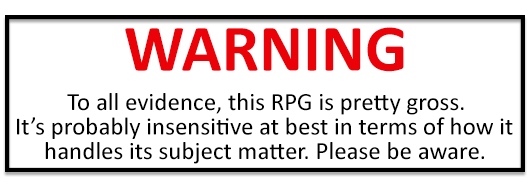
Introduction
Original SA post Supplement V: Carcosa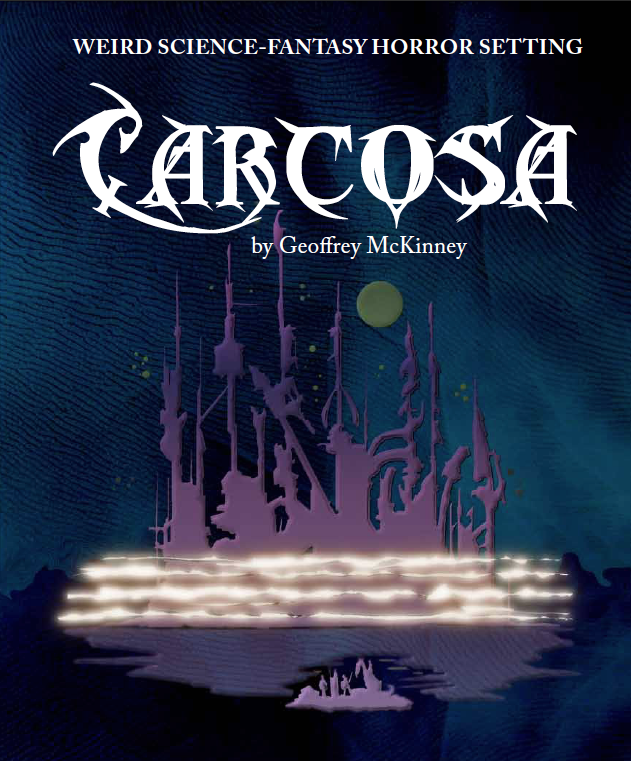
"Presented in one volume expanded edition consisting of
a rough account of what transpires in the wildernesses
around the lake Hali and mysterious Carcosa as well as
the laws of play regarding events therein."
In 2008, some guy named Geoffrey C. McKinney released a PDF work he called Supplement V: Carcosa . What's with that title? The game styles itself as a supplement to the original brown-box addition of Dungeons & Dragons , after Supplements I-IV: Greyhawk, Blackmoor, Eldritch Wizardry, and Gods, Demi-Gods, and Heroes . Pretentious? Maybe a little.
This isn't a review of that PDF, though. See, in 2011, James Raggi, noted metal geek, creepy petit-fascist, and publisher of Lamentations of the Flame Princess decided Geoffrey's work was so brilliant that it needed to be republished with an expanded pagecount, all-new art, and in both PDF and hardback! The new PDF is what I'm reviewing. And since Geoffrey's allowed his old blog for Carcosa to be swallowed by a spam shoggoth, who are you to argue?
Part I: Introduction
"You hold in your hands a weird science-fantasy supplement for traditional fantasy role-playing games, containing both rules and a setting. You will not find within long-winded histories or encyclopedic descriptions of countries, forests, and rivers. Instead, the world of Carcosa is presented as a numbered hex map filled with 800 encounters and the rules to use them." Hoo, boy.
Carcosa starts off by telling us what a special snowflake it is. It's not Tolkienesque mainstream fantasy with dwarves and dragons and magic swords, oh no! It's meant to be equal parts science fiction, early-20th century "weird fantasy," and sword-and-sorcery. This isn't your daddy's fantasy, pal! This is your granddaddy's fantasy! (I don't think my granddaddy read much pulp fantasy, though. He was too busy clearing rocks out of a field to feed his family, much like Clark Ashton Smith!)
To its credit, Carcosa goes right into laying out what makes it markedly different from most D&D-type settings:
--There are no wizards or clerics, and none of their standard spells--no magic missiles, fireballs, stink clouds, or cure light woundses. Instead, the only magic consists of sorcerous rituals to summon behemoth Lovecraftian creepy-crawlies.
--There are no dwarves, elves, hobbits, orcs, or any of that crap. Instead, the humans of Carcosa come in different colours. Seriously. More on that later.
--Carcosa's monsters are different, m'kay?
--There are no magic items, just alien artifacts.
--Carcosa has a psionics system which is "short, simple, and easy to use." Okay, here's a reminder: Whenever something in Carcosa is described as "simple and easy-to-use," that's a lie.
Next Time: Dice conventions! This is more fun and less sane than it sounds.
Dice Conventions, Weapon Damage, and Asperger's Syndrome
Original SA post Supplement V: Carcosa"Often this book will instruct the Referee to roll dice, but
will not specify what sort of dice to roll. The two most
obvious examples are hit dice (whether for characters or
for monsters) and dice to determine damage in combat. In
such cases, the Referee should roll on the following table to
determine which dice to use:"
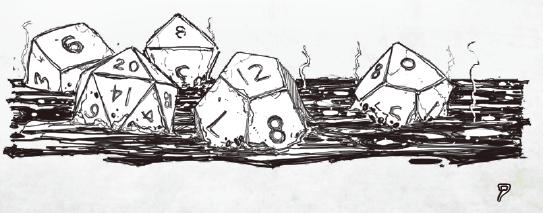
Spoooky dice soup
Part II: Dice Conventions, Weapon Damage, and Aspberger's Syndrome
When playing Carcosa, you roll a little differently than in other old-school D&D games. Specifically, everything is random as fuck. In Carcosa, PCs don't roll a hit-die to find out how many more hit points they get at each level, oh no. Instead, at the beginning of every combat, each PC rolls a d20 and consults a table to determine whether he has d4, d6, d8, d10, or d12 hit dice, then rolls and totals to determine his hit points for this combat.
(Yes, I know I'm using the male pronoun as default. Trust me, considering the fates of most women in the art in anything James Raggi publishes, you'll be glad I assumed no women are PCs in this game.)
That's right, your level 8 fighter might have somewhere between 8 and 32 hit points in one combat and between 8 and 96 hit points in another. This applies to each type of monster, too, so if you're fighting 3 Deep Ones, 2 byakhees, and Cthulhu, you roll once for the Deep Ones, once for the byakhees, and once for Cthulhu, and then roll to determine hit points for each creature. Cthulhu has 57 hit dice, but it's still possible for him to have fewer hit points than each of his minions or your fighter.
Did I mention that you have to leave all the hit dice you rolled for your PCs on the table? That's right. Because when you lose hit points, you actually take those dice away, starting with the highest rolled. For example, if your level 8 Fighter was lucky enough to get d12 hit dice and rolled 2, 3, 3, 5, 7, 9, 10, 12, after he takes 12 HP of damage you take that 12-die off the table. If you have another combat before you get a chance to rest and restore hit dice, you repeat this entire process, only with fewer HD to roll. Christ, I need a drink.
Weapon damage! All weapons do one die of damage, whether dagger or battleaxe. Every time you roll damage, roll one of each die--d4, d6, d8, d10, d12, d20. Compare the d20 to the table to determine which of those other dice you're actually using to determine damage. A dagger can do 3 damage on a d4 the first round and 2 damage on a d12 the second! And you only had to roll 10 dice and look up a chart twice to achieve this level of crazy, Lovecraftian, weird fantasy randomness, bro!
Next time, on Carcosa : Characters! Which is to say, magic rapists!
Characters. That is to say, serial killers.
Original SA post Supplement V: Carcosa"All rituals (except for rituals of banishment) require
human sacrifice, and all except banishings require long
ceremonies (typically at least an hour) to perform along with
much paraphernalia. Sorcerers will travel hundreds of miles
for a single component (“the purple fungus that swells only
in the Cracks of Dslath,” for example). Many rituals can be
performed only in a specific place and/or time. Performing
rituals is often dangerous for the Sorcerer.
Sorcerers may not perform sorcerous rituals if more than
heavily encumbered."
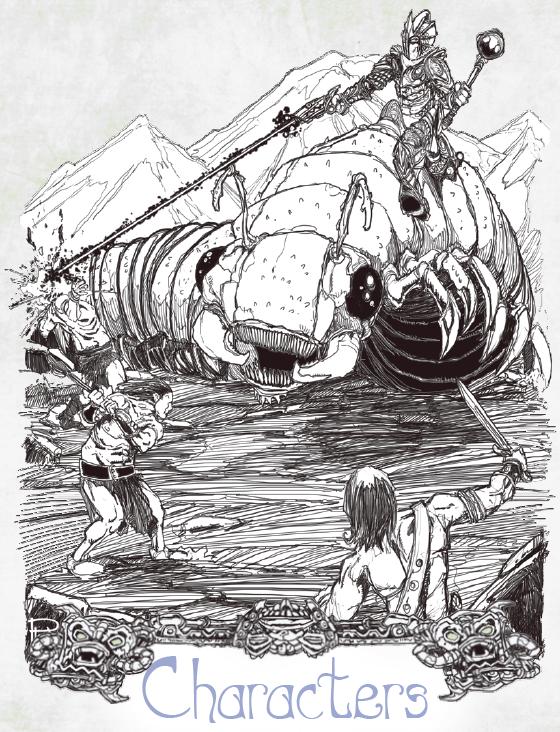
Drive me closer! I want to hit them with my giant baby rattle!
Part III: Characters. That is to say, serial killers.
Like I said before, Carcosa has no magic-users, clerics, rogues, or battleminds. There are only two classes: Fighters and Sorcerers. Sorcerers can do anything fighters can do--they can wear any armor, use any weapon (which makes no difference as weapon damage is randomized) and have the same hit points (where there can be no difference because HP are randomized).
The difference is that Sorcerers have better saving throws, and can cast rituals devised by the extinct species of Snake Men. (If you give a shit, I once read a forum post from the author wherein he explains that sorcerers spend years of training learning the language and ritual methods of the Snake Men, so it's not something you can learn during the course of a campaign.) The text graciously includes notes that casting rituals always includes human sacrifice (except banishing), is usually dangerous, and learning and casting a single ritual can be a dangerous and lengthy quest in and of itself.
There are six types of rituals.
Conjuring rituals summon entities.
Banishing rituals force the entity to flee.
Invoking rituals telepathically contact entities, usually for the sake of learning other rituals (or, say, where to find a necessary component).
Binding rituals compel obedience for a certain period as specified by the spell.
Imprisoning rituals confine an entity to a particular place, and
Tormenting rituals inflict agony on an imprisoned entity--for what purpose, I don't yet know.
A fun note on binding spells: The sorcerer only knows how long the entity is bound 50% of the time, regardless of level. So after completing horrific rituals involving pricelessly rare components and unspeakable acts of human sacrifice, half the time you're tempting fate regarding when Cthulhu slips his leash and sucks your sweetbreads out through your asshole and throws your soul into a giant non-Euclidian frying pan for all eternity.
Oh, and did I mention the entity gets a saving throw to resist the effects of a ritual? It takes a -1 to -3 penalty if you're a high-level sorcerer, or a bonus if you're trying to free it from imprisonment. You also have to make a saving throw vs. magic, or else roll a d20 and (of course) consult a chart to determine unnatural aging of 1-5 years.
The Races of Man
Remember when I said there were no playable demihumans on Carcosa? What you get instead are the 13 Races of Man: Black Men, Blue Men, Bone Men, Brown Men, Dolm Men, Green Men, Jale Men, Orange Men, Purple Men, Red Men, Ulfire Men, White Men, and Yellow Men.
Humans on Carcosa are divided into starkly colour-coded Races which are actually separate species: they mistrust one another, and cannot interbreed. Black Men are coal-black, White Men are chalk-white, and so on.
It's stated somewhere that the different species of human were bred by the Snake-Men so they'd have an ever-ready supply of ritual sacrifices. To be fair, that's a pretty cool idea.
Bone? Jale? What?
Bone Men are completely transparent except for their bones. The other races mistrust Bone Men even more than usual. Jale, Ulfire, and Dolm are colours which don't exist on Earth; the book notes that they're taken directly from David Lindsay's "A Voyage to Arcturus," a science-fantasy published in 1920. Jale and Ulfire are primary colours; Dolm is ulfirish-blue.
Excepting Bone Men, all humans have dark hair and eyes, with slight tints of their skin colour in the case of the more vividly-coloured races.
Alignment
Carcosa uses the OD&D alignments: just Law, Neutrality, and Chaos. As in Lamentations of the Flame Princess, alignment has nothing to do with morality, really. Your alignment is determined solely by your attitude towards the Great Old Ones. If they were released en masse upon the world, Lawful characters would oppose them, Neutral people would just try to survive, and Chaotics would embrace their return.
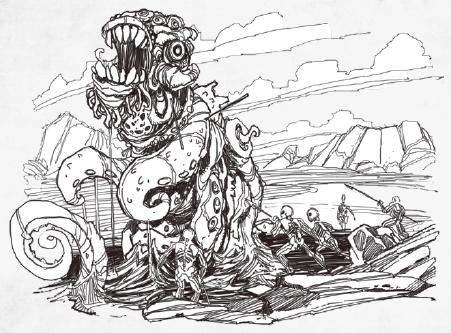
BEEEAAANNNS WALKS SEREEENE AND PRIMAL

Psionics
Any character with an Intelligence, Wisdom, or Charisma of 15 or higher has a chance to know psionics, which you determine by consulting another fucking chart and rolling percentiles! If you're psionic, you can use psionic powers 1-5 times per day depending on level. You roll a d4 at the beginning of each day to determine how many of the 8 psionic powers you can use today; the DM determined these randomly--might as well be with a d8 roll.
Clairaudience lets you hear through solid objects within a range of 60 ft. Lead or 2 ft. of stone blocks the spell.
Clairvoyance is as above, but for sight. X-ray vision!
ESP is just as above, but for reading thoughts!
Mental blast does 3 dice of damage. Other psychics can negate the damage with a save vs. magic.
Mind control does exactly that to a victim who fails a save vs. magic. In order to maintain control, the psychic must stand still and concentrate. Trying to mind-control a Great Old One will knock you unconscious for 1d hours unless you make a save vs. breath weapon. Yes, that's right.
Precognition : "This allows the user to tell what will happen only to himself
if he were to do something. No more than 1 minute into the future can be seen."
Telekinesis : For up to one hour per use, you can move 20 lbs./level within a range of 120 ft.
Telepathy allows simple mind-to-mind contact. The DM is advised to require a saving throw if you're dumb enough to use this on the Old Ones.
Next time, on Carcosa : Black Lotus! From Stygia, the best! I would sell haga to a slayer such as you?
Lasers! Eight o'clock, Day One!
Original SA post Supplement V: Carcosa"The Space Aliens are adept at modifying organisms with
robotics, as well as at enhancing robots with biological
material. While the majority of cyborgs are roughly 50%
robotic and 50% biological, they vary widely nearly pure
robots (e. g., a robot with a biological brain) to merely
modified organisms (e. g., an animal with a violet laser ray
implant) A simple way to determine the characteristics of
a specific cyborg is to randomly generate a spawn of Shub-
Niggurath (page 244) and then roll some robotic characteristics
for it on the Random Robot Generator (page 258), or vice versa."
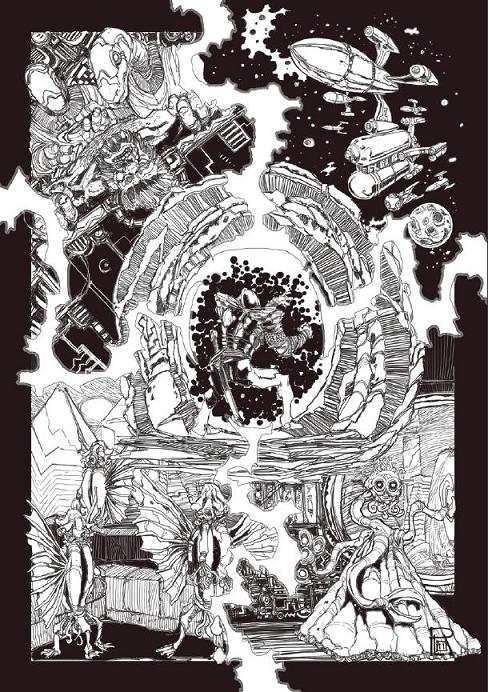
Look, Judge Dredd isn't allowed to DJ anymore, okay? I fucking mean it. I'm sick of that techno remix of "Cotton Eye Joe."
Part IV: Lasers! Eight o'clock, Day One!
This is the part of Carcosa that discusses all the weird science-fantasy gadgets and poisons and potions and unguents and such you can find lying around Hex 1241 in the Bleak Desert of Squamous Pulchritude or whatever.
Desert Lotus
For some reason, the potent Desert Lotuses get a full page, half of which is an illustration that looks like a giant carnivorous cactus flower. There are several types of desert lotus, all of which grow underground or "in shady areas of deserts, where they thrive in the light of the moon." They're identified by--can you guess?--colour, of course! After a week-long process, each can be made into a potent alchemical powder.
Black : Instant death for anyone who fails a save vs. poison with a -6 penalty.
Blue : Causes near-ageless suspended animation. Tiny quantities of black lotus counter the effect, with a failure rate of 10% that results in instant death, of course.
Green : Puts you in a coma, then you wake up extremely sick and weak, permanently. This lotus gives you incurable Lyme Disease, basically.
Jale : Causes hours of "nightmarish hallucinations," followed by permanent insanity (75%) or death (25%).
White : Permanently turns you into a mindless zombie, to be enslaved to the first person who happens upon you after you're dosed and suggests you do something.
Quite bizarrely, none of these requires you to do anything with a chart or table.
Space Alien Technology
Hoo boy, this is the fun part! This section details all the artifacts you can find which were created by the Space Aliens. Who are the Space Aliens? Greys, although it never says so directly. Fortunately, their basically humanoid shape means that humans can use their kickass stuff. Considering that the monster section says that the Aliens have been intermittently establishing outposts on Carcosa for millennia, it seems odd that they would let their weaponry fall into the hands of Snake Men food. But nevermind! I want an ulfire laser bazooka! I'm not going to list every single item, just enough to make you wonder how much he just copypasted from Gamma World.
Projectile Weapons : This entry refers you to the appendix, which shows you how to randomly generate projectile weapons. This only requires you to roll on 4 tables! Type (pistol, rifle, bazooka, cannon, tank ), Projection Pattern (pulse, beam, ray, wide-angle emitter) Projection (Electromagnetic, Elemental, or Special) and then a subtable for that Projection Type. There are enough potential combinations that I'm compelled to provide fun examples, ranging from straightforward to goofy:
Microwave radiation beam rifle
Ulfire laser beam bazooka
Polymorphing ray cannon
Potassium ray pistol (Does double Damage to Bone Men, but only half to Orange! Yes, there is an entry for every element on the periodic table. Don't ask me why Black Men take half damage from weaponized Ytterbium.)
Dolm pudding emitter tank (meaning a tank that attacks everything in a 10-mile radius with carnivorous acidic slime)
There are also power packs for these weapons, and grenades, bombs, and missiles that have similar effects, rolling on the same random tables.
Reflective Suit : Outright prevents damage from 1-20 random elemental types and 1-4 random colours of laser!
Battle Armor : Provides AC 19, and is likely to come with several types of weapons and features. They're "20% to 50%" likely to have one of several upgrades, which I suppose means rolling a 1d4 to determine that percentage chance, then rolling that chance for each upgrade listed! These babies can provide antigrav flight, vacuum protection, underwater protection, strength enhancements, or a force field, in addition to "typically" being outfitted with 1-4 random weapons.
Force Fields : Belt-mounted devices that absorb 10-100 points of damage. Suck it, Paul Atreides.
Absorption Fields : A force field that actually gets HP restored by 2d6 kinds of damage.
Robots : You create these babies by consulting the Random Robot table in the appendix; the text flat-out says that the Space Aliens must not have approved of mass production. The robot's basic chassis can be humanoid, insectoid, spheroid, myriapod, serpentine, coil-shaped (like a Slinky, I swear to God), or "bizarre." After rolling on a pile of random tables to determine what environments they move in, what kind of limbs they use to do that, and their Speed, HP, and AC, you roll for their built-in weapons, defense systems, and special senses like radar. The book also includes a full-page with illustration suggesting additional capabilities like translating languages, a self-destruct mechanism, or a suite of limbs designed to perform horrible vivisections! Moving on, you can try to reprogram a robot, with an 80% chance of nothing, 10% chance of provoking a murderous rampage, and a 10% chance of enslaving it to your will.
Cyborgs : As with robots, except it recommends rolling the thing up as a Spawn of Shub-Niggurath before adding robot abilities. Holy shit.
Technological Artifacts of the Great Race
The Great Race are, of course, the Yithians from Lovecraft's "The Shadow Out of Time." (Curiously, in Carcosa they're identified along with several other mythos races as having been spawned by Shub-Niggurath.) They apparently didn't create (or at least, leave behind) various and sundry gadgets for humans to find and fuck around with. Only four artifacts are detailed here, and they're all large, impressive, and very rare machines.
Great Race technology isn't designed for humanoids, and is mainly concerned with fucking around with space and time itself. Only humans with Intelligence 17+ can even try to user Great Race tech, and it requires months of study (a cumulative 5% chance each month).
Crystalline Psionics Chamber : This thing is a giant psionics-enhancing crucible for any psychic using it. It allows you to use all 8 psionic powers, multiples your uses by ten, multiplies the range and damage of all psionics by 10, give a -5 penalty to saves vs. mind control, and enhances precognition to ten minutes into the future. However, the stress requires a saving throw or you permanently lose your psionic powers.
Scrying Glass of the Old Ones : This allows you to spy on the Great Old Ones in their cosmic prisons. This has the nifty effect of forcing you to observe the Old One, and make saving throws or else become their ardent worshiper. It's possible you might learn some arcane lore from your visions, if the DM feels like it.
Spacial Transference Void : A big black rip in the fabric of space. Anyone standing near it must make a save or be compelled to hurl themselves into it. You can use it to travel to any celestial body you like, but you'll need to make a saving throw if you don't want to accidentally travel into deep space or an environment that will immediately destroy you utterly. Assuming you survive the trip, you can return with a few minutes of concentration!
Temporal Transcendence Gulf : A massive chunk of metal and psionic brain matter, the Gulf exists in all times at once. Therefore, you can use it to travel to where the Gulf is, at any point in time! You'll need to make a saving throw not to have your particles smeared across the space-time continuum. Oh, and even if you do, there's no guarantee that you won't be traveling to a point in time wherein the Gulf is located underwater, or under a volcano. Don't forget to wear your sunscreen!
Technological Artifacts of the Primordial Ones
The Primordial Ones are the Elder Race from Lovecraft's "At The Mountains of Madness." They are barrel-shaped, ridged, winged, tentacled, many-eyed creatures exhibiting radial symmetry and a half-animal, half-vegetable nature. As with the Yithians, the Primordials are curiously identified as a race created by Shub-Niggurath, and also as haters of all other sentient species. They're also identified as "almost incomprehensibly inhuman," despite the fact that part of the horror in Lovecraft's story was that despite their completely alien biology, their psychology was remarkably easy for a human to empathize with. Anyway, their long-lost technological crap is mostly biomechanical and humans have the same difficulty understanding and using it that they have with Great Race artifacts.
The Carven Rim : This is the crater left by a vast sporelike entity crashing into the earth, which the Primordials managed to manipulate into a sort-of factory for creating gaseous beings. A human using it can create a gaseous being which is guaranteed to immediately attack its creator, causing a 40% likelihood of dissolving into gas, 20% chance of poison, 20% chance of disease, and 20% chance of random mutation. So basically, don't ever go near this thing for any reason at all.
Elder Sign : A funny little nearly-indestructible star-shaped stone. Deep Ones will flee from it.
Fecund Protoplasmic Pit : A vast pit of dolm ooze, rimmed by a panel of many biomechanical knobs and levers. You can use it to create life! To sum up, it has a 44% chance of creating inert goo, a 44% chance of creating one of several ooze monsters, a 6% chance of creating a Spawn of Shub-Niggurath that just lumbers off, a 3% chance of creating a Spawn that immediately attacks you, and a 3% chance of creating a Spawn that will serve you. For fun, tell me the point in this paragraph where playing with this thing sounded like an incredibly stupid idea.
Living Monolith : This one is actually kind of cool, yet terrifying. In other words, it's what this entire chapter should have been about. The Living Monolith is a 100 ft. high column of amalgamated organic matter than oozes, sighs, and screams, provoking hysteric terror. Anyone who can figure out how to meddle with it properly can extract bulk quantities of any kind of organic type, which can be developed into creatures which will obey their creator.
Mutation Inducer : A bulky, spiky, vaguely-rifle shaped weapon with infinite charges, which induces a random mutation (more on those later!) with each failed save by the target.
The Primal White Jelly : A small, white, jellyfish-like blob which randomly mutates in the presence of other living creatures. If you can divine its secrets, you can use it as base matter to grow any type of creatures, although they won't be under your control.
Proto-Shoggoth : A sort-of Shoggoth which can be controlled by a human will, and mimic the features of just about anything except a Great Old One.
Next time, on Carcosa : My organ had been prolonged and its release was intense and my knees are weak. I’m naked too, shouting “You bitch, you piece of bitch trash” at her and since most of the blood is coming from her feet, she slips, manages to get up, and I strike out at her with the already wet butcher knife that I’m gripping in my right hand, clumsily, slashing her neck from behind, severing something, some veins. When I strike out a second time while she’s trying to escape, heading for the door, blood shoots even into the living room, across the apartment, splattering against the tempered glass and the laminated oak panels in the kitchen. She tries to run forward but I’ve cut her jugular and it’s spraying everywhere, blinding both of us momentarily, and I’m leaping at her in a final attempt to finish her off. She turns to face me, her features twisted in anguish, and her legs give out after I punch her in the stomach and she hits the floor and I slide in next to her. After I’ve stabbed her five or six times—the blood’s spurting out in jets; I’m leaning over to inhale its perfume—her muscles stiffen, become rigid, and she goes into her death throes; her throat becomes flooded with dark-red blood and she thrashes around as if tied up, but she isn’t and I have to hold her down.
Sorcerous Rituals, or Vice Amply Rewarded
Original SA post Supplement V: Carcosa“This eleven-hour ritual can be completed
only on a fog-shrouded night. The Sorcerer must obtain
the root of potency found only in ruined apothecaries of
the Snake-Men. The sacrifice is a virgin White girl eleven
years old with long hair. The Sorcerer, after partaking of
the root, must engage in sexual congress with the sacrifice
eleven times, afterwards strangling her with her own hair.
As her life leaves her body, 10–100 of the Amphibious
Ones will coalesce out of the mists.”
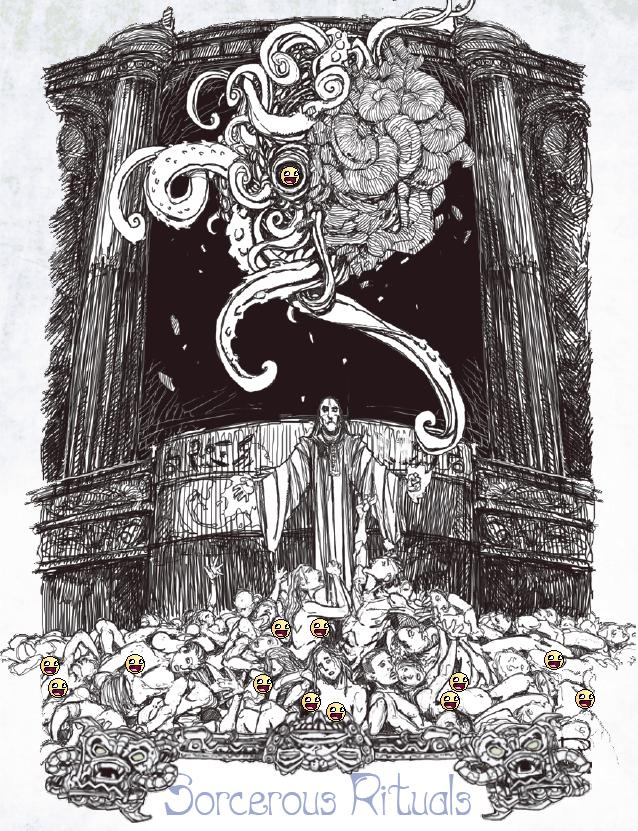
Part V: Sorcerous Rituals, or Vice Amply Rewarded
If you're even interested in reading about Carcosa in the first place, you've probably heard about its most controversial content--magical rituals which nearly always require human sacrifice, not to mention torture and rape. The ritual above, “Summon the Amphibious Ones,” was quoted by the publisher, James Raggi, in his longwinded, puerile apologist review of the game's original edition.
That's right. Summoning an army of frog monsters requires you to rape a virgin girl repeatedly and then strangle her to death. This is really only the tip of the iceberg for the Sorcerous Rituals in Carcosa. Because I apparently hate myself very much, and in the interest of identifying any particular bias on the part of the author, I went through the chapter and categorized what kind of sacrificial victims are required, and how they are murdered and/or tortured.
There are 95 rituals in Carcosa. As explained in the Characters section, rituals are divided into Invocation, Conjuring, Binding, Tormenting, Imprisoning, and Banishing types. Only banishing rituals never require human sacrifice, although they sometimes require animal sacrifice--one requires you to burn a mammal alive. Fifteen of the 95 rituals are for banishing.
(Based on the wording of certain rituals, I realized that "Orange Men" might refer to Orange men or women, with "Men" meaning humanity, as in Tolkien. Rituals also sometimes call for a number of victims of any kind, or of a particular colour. Thus, I assume that victims are adult unless otherwise specified, and that Red Men refers to Red adult males, unless otherwise specified.)
So, here is a breakdown of the rituals as a whole, excepting the 15 banishing rituals. These are discrete categories and there is no overlap, excepting a couple cases wherein one ritual enhances another:
Victims tortured but not murdered: 1
Child victims tortured but not murdered: 1
Adults murdered: 8
Adults painfully murdered: 4
Male adults murdered: 12
Male adults painfully murdered: 22
Female adults murdered: 10
Female adults painfully murdered: 3
Rape and murder of an adult woman: 1
Children murdered: 5
Male child painfully murdered: 1
Female child murdered: 1
Female child painfully murdered: 4
Rape and murder of a female child: 3
Murder of an infant: 4
I can’t explain all the murderous rituals, of course. But in order to give some character to these raw statistics, let’s look at a few case studies which I consider the...standouts, you might say.

Clearly there’s been a misunderstanding. The Snake Men were just planning a barbecue.
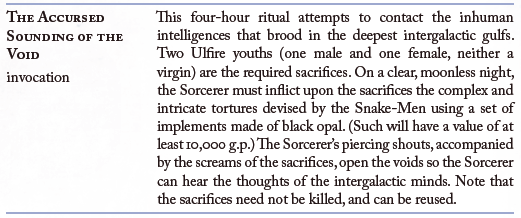
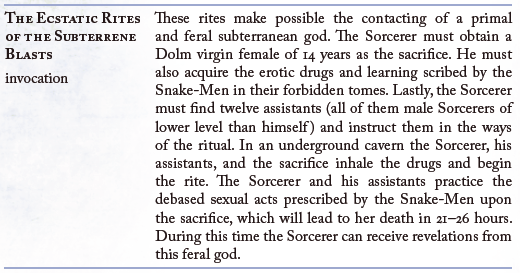
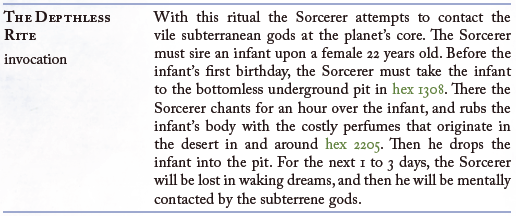
All work and no play makes Jack a dull boy. All work and no play makes Jack a dull boy. All work and no play makes Jack a dull boy. All work and no play makes Jack a dull boy. All work and no play makes Jack a dull boy. All work and no play makes Jack a dull boy. All work and no play makes Jack a dull boy. All work and no play makes Jack a dull boy. All work and no play makes Jack a dull boy.
Sorcery is apparently an all-male profession; only the masculine pronoun is used, and acts of rape are only ever described in terms of a man raping a woman. (Sure, I'm going to rape a Jale virgin and stab her in the heart in order to Consign the Inky Crawler to the Lightless
Lake, but NO HOMO.)
McKinney never bothers to explain the metaphysics behind how or why sorcerous rituals work. Therefore, he doesn't explain why the Old Ones or the forces that summon them need death, rape, and torture as catalysts, or why they care whether or not the victim is a certain age, a warrior, especially beautiful, or a virgin, as a number of rituals do. Besides, weren't these rituals designed by the Snake Men with humans as their fodder? I don't want to know how a Snake-Man rapes a human woman, and I can't think of any real-world religious traditions that call on the supplicant to rape a very pretty goat to death. (If there are, please don't enlighten me.)
I'm sure that if asked, McKinney or his publisher would take refuge in tradition, citing weird fantasy pulp stories wherein robes cultists were determined to sacrifice beautiful virgin girls. For one, I think it was implied in those stories that it was the superstitious cultists who cared about the nature of the victim, not their primordial alien "god." For two, we all know the real reason he included this shit is because it's lurid and it pushes buttons and that means he's all over it like maggots on a dead skunk.
But hey! Let’s set our judgment aside. We could be missing something truly innovative just because the content offends us. Let’s see what the publisher, Raggi, had to say about those who would dismiss Carcosa out of hand just because it devotes page after page to talking about rape and murder:
quote:
It’s one thing to think, “That’s icky, I don’t want to use that sort of thing in my games,” and not buy the product. It’s OK to state that. Nobody should feel compelled to like or participate in a game or setting (whether originating with the rules or the individual game group) that makes them uncomfortable (and for you, there is an “Expurgated Edition” of Carcosa which omits the most egregious descriptions of violence, an amount of text so insubstantial that the book’s page count does not change for their absence). But actual outrage and condemnation of fictional circumstance? Ridiculous! And worse than the morality police that take offense at atrocities (which don’t really happen) against people (that don’t really exist) are those who seek to “protect” our hobby by trying to kill anything that might be noticed by outsiders and regarded as “abnormal.” They aren’t personally offended, but they worry when someone else might be. “The accusations will start again! It will be the Bad Times again!”
Cowards!
Those who seek to imprison our minds and define “good thoughts” and “bad thoughts” should be ignored in our daily lives, defied in our imaginations, and fiercely fought, in real life by real means, whenever they seek to limit us.
This fear of attention and censure and the horror at the idea that maybe, just maybe, we really are different because we pretend to be elves on the weekend, it needs to die. At once. Completely. Let your imagination go and damned be those that say no. We should welcome fights against imagination killers simply because it is the right thing to do. Those that stand up and dare to be targeted should be praised, not vilified.
But we, as a community, obviously haven’t learned a thing from the controversies of the 1980s. Gamers of the 70s and 80s survived the persecution and ignorance and harassment only to grow up and often become exactly what they once fought. Like the definition of becoming mature is being willing to embrace your parents’ mistakes or something.
The problem with the 1980s attacks on D&D wasn’t that they were wrong about the content – although the fact that they often were made it easy to totally dismiss them – it was the fact that the content of the game and the fictional environment of the game has absolutely no influence concerning the real-life mentality, ethics, or health of the person playing the game. People influence the game being played, not the other way around. Milquetoast gamers will have milquetoast games, and only those already of a mind to entertain uncouth elements will insert those elements into play.
To be very clear: Nothing in Carcosa even suggests that anything within its pages is anything but pure fiction. The setting is an alien world, with reptile men and Cthulhu and ray guns and tanks and people with transparent skin. It’s all fiction.
And nothing in fiction can ever be as immoral or harmful as the real life censorship of ideas.
That’s right, it’s time to set the record straight. Telling other people not to buy something because it’s tasteless? Condemning an artistic work for glorying in rape and murder? Literally censorship! And if you label thinking about rape and murder all day as “bad,” hoo boy, you are officially a pox on human civilization! Stop trying to commit the Holocaust against my imagination, Fun Hitler.
But let’s pretend Raggi’s not a contemptibly sophomoric excuse for an intellect, and set aside any moral judgment of the content in Carcosa. What does that leave us with? Mainly, with page after page of stuff that’s not very useful in gameplay.
Most of these rituals are really difficult to pull off if the DM isn’t coddling you. Take, for example, Cast Into the Icy Void, a banishing ritual that requires no violence against any humans. You need at least a quart of lava, a container that can hold lava and keep it from cooling or melting the container, and to spend ten minutes casting before you hurl the lava onto the God of the Primal Void, banishing it. That’s a pretty tall order to accomplish before the God of the Primal Void freezes you solid and eats you.
Various rituals require you to gather specific types (or a large number) of victims, to have paraphernalia that can only be gathered with great difficulty from a particular hex, to perform the ritual in a particular place or under particular conditions, and/or subject yourself to save-or-die effects. In short, most rituals require enough difficult-to-achieve factors that casting one of them, let alone the different rituals required to conjure, bind, and then banish or imprison a single Old One, could be the focus of an entire campaign.
I anticipate a particular reaction to that last statement, that being “But that’s great! Infinite possibilities! So much content!” It’s really not. A book does not need 33 pages and its entire magic system devoted to what are only campaign seeds. While I’m loath to encourage Carcosa to have more random tables, whatever value is in the sorcerous rituals section could be better served up as lists and summaries of the kinds of components that can serve in rituals of varying difficulty and involvement, rather than pages and pages of specific descriptions. I once made some notes for my own use on how more sword-and-sorcery style ritualized magic, rather than instantaneous lightning bolts and fireballs, could be included in rules-light games like Savage Worlds and Barbarians of Lemuria. I identified high-level rituals as essentially plot devices that didn’t need precise mechanics, and noted that an entire campaign could hinge on casting a ritual that did things like summon an undead army to fight for the caster, raise a lost city from the desert and restore it to fecundity, create a new species, or grant an individual demigodlike power. I also made notes on what kinds of components would be required for such a ritual--a one-of-a-kind valuable artifact, a nigh-inaccessible location, one particular time during a century, or a very rare and particular human sacrifice, or mass human sacrifice. I didn’t need to sit for an afternoon thinking of five different ways to rape a little girl to death. I never even thought about it. Clearly, the cowards got to me.
The Fungoid Gardens of the Bone Sorcerer
Original SA post Supplement V: Carcosa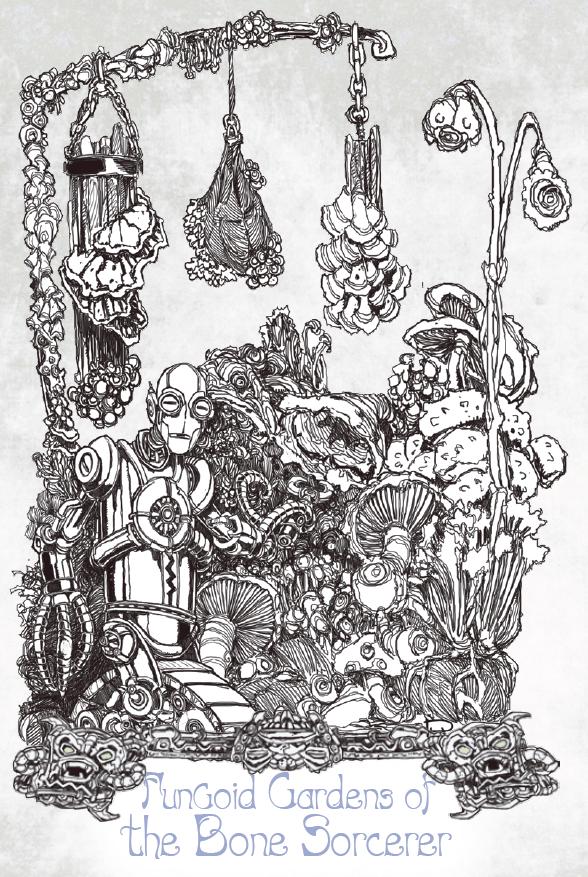
What's better than a dozen roses on your piano?
Part VIII: The Fungoid Gardens of the Bone Sorcerer
Carcosa includes a sample adventure, "Fungoid Gardens of the Bone Sorcerer," recommended for new characters and campaigns. It takes place in Hex 2005, which the previous chapter tells us also contains a "Village of 370 Yellow Men ruled by 'the Incomparable Crown,' a chaotic 5th-level Fighter." In true, uh, Carcosan fashion, the adventure splits up the hex into a number of "sub-hexes," which it feels the need to inform us are 0.4 miles across. The center of the hex is sandy desert, and the northern half constitutes the barren Blighted Lands, with a brief table to let you know you're likely to encounter Mi-Go, Yellow Men, or various slimes and oozes there.
The Yellow Men, we are told, worship a Spawn of Shub-Niggurath called the Consumed God, which feeds the village from its bodily secretions, "a sweet substance like undercooked bread" in exchange for human sacrifice. Blood and souls for my Lord Pillsbury! The monster is a giant psychic amoeboid that induces madness on sight, which must make it hard to harvest the god-dough.
The central desert has its own encounter table, of course, which is a much more motley assortment: cannibals, dinosaur riders, Space Aliens, mummies, and of course, Spawn of Shub-Niggurath. The desert areas contain the necessary components for 6 rituals, not to mention various desert lotuses--but the chance of finding any particular one is only 1% cumulative per day, making it very likely you'll be eaten by a monster before you get the chance to get eaten by a monster after raping someone and summoning it.
There's a Space Alien outpost protect by a force field and permanent weapons batteries, which stop working even if you somehow manage to steal them. This encounter is very much in keeping with the spirit of Carcosa: Something that you should stay away from because it's useless and will only harm you.
There's a band of Lawful dinosaur-riding barbarian mercenaries, who want nothing more than to annihilate the Bone Sorcerer and the village of Yellow Men. They hate anything that stinks of sorcery or the Old Ones.
There's also a crypt with mummies who know a few rituals and would be glad to teach you how to worship Nyarlathotep. For whatever that's worth.
Finally, we come to the fungoid gardens of the Bone sorcerer! There's a map of the dungeon, which is just an extended cave with fungi lining every single surface. The encounter table (of course!) includes giant snails, White Lotus zombies, Spawn of Shub-Niggurath (as always), the Bone Sorcerer or his apprentices, and Fearful Fungi.
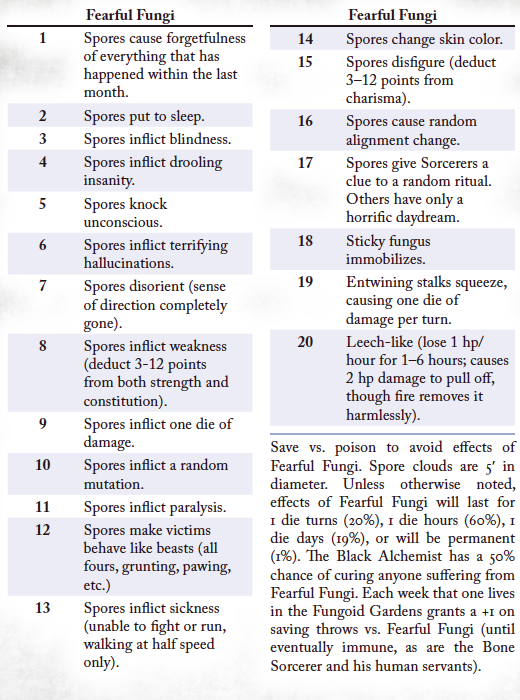
Other than the fungi on fucking everything, the "gardens" contain about everything you'd expect in a sorcerer's underground suckdungeon--bones, bats, mold, an alchemist's laboratory, a whole lake of slime--and some other things. The sorcerer worships a Lake Monster by offering it a Yellow child everything. (Every month ? Even if they're willing to sell, how many young children does a village of less than 400 produce each month?) There are 30 White Lotus zombies, a Black apprentice who tends the fungus,
The Bone Sorcerer is, of course, a Bone Man, wearing plate mail and wielding a beam gun and a club. No information on is personality is provided, but he's willing to hire or apprentice the PCs! He knows some rituals, including a very special one.
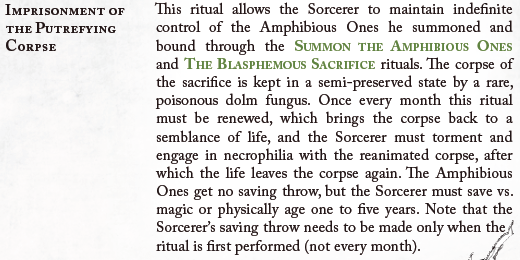
As far as I know, the Amphibious Ones are the only monster subject to a triple-decker stack of rituals--you can subject a White girl to unspeakable torture, then rape her over and over and strangle her with her own hair, then keep reanimating her corpse for another round of agonizing torture every time you need to keep your frog-monster minions in line.
The most insight we get into the Bone Sorcerer is from the details on his fungus gardens. Apparently, he is stoned to the fucking gills on fungus-drugs most of the time, trying to learn the details of rituals from the hallucinations. If you want to try it yourself, there's a table to see if you learn anything or just have something horrible happen to you.
The caves also contain a couple of armed apprentices, a store of booze and rations, more Spawn and Amphibious minions. By far the most interesting feature of the cave is an Unquiet Worm--a worm which feeds on a dead sorcerer's brain, acquires its memories, and swells into a grotesque humanoid worm-thing. It's been trapped in an abandoned shaft for thousands of years, is completely crazy as a result, and desperately wants to break free and get revenge on a particular Old One.
There's also a Deep One lair. It contains Deep Ones, Spawn, giant slugs, an idol to Cthulhu, and is otherwise a pretty boring frog-beast cave.
Next time, on Carcosa : "Humanity on Carcosa." Such as it is.
Humanity on Carcosa
Original SA post Supplement V: Carcosa” Anthropological description is intentionally kept to a
minimum in this work so as to preserve the greatest latitude
for each Referee to make Carcosa his own.”
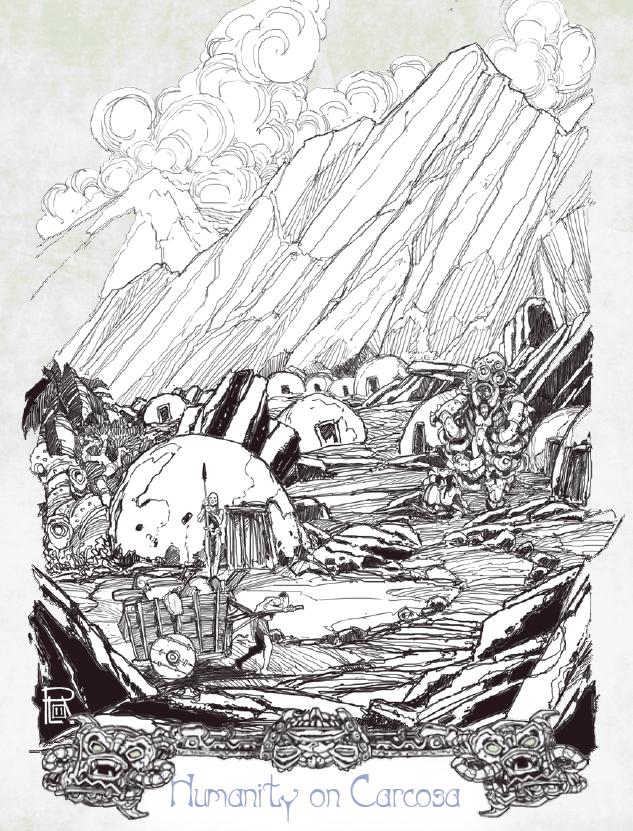
"Mornin' Sam."
"Mornin' Fred."
Part IX: Humanity on Carcosa
The author includes a brief, two-and-a-half page summary of how he envisions human culture existing and functioning on Carcosa. This, and those voluminous hex descriptions, are what passes for the “setting” of Carcosa. This is intentional, says the author, so as to interfere as little as possible with the DM realizing his own Glorious Vision. I understand that this approach is much preferred by a lot of old-school hexcrawl addicts, but to me it just seems like an excuse for not being able to write setting and filling the book with stuff that you could generate yourself with the random tables.
People on Carcosa don’t really have mythology as we know it—they don’t need to, when monsters are real and ever-present. They don’t have much in the way of history, either; only a fraction of sorcerers know that humankind was invented by snake-men. Humanity is pretty emo, on the whole—life is hard, monsters are everywhere, and people are generally aware of the fact that the human species isn’t even near the top of the food chain, and other intelligent species have already invented super-advanced technology. People would much rather steal things than invent them.
The author says that the cultures which Carcosa most resemble are precolonial sub-Saharan Africa, pre-Columbian Mesoamerica, and the tribe from Peter Jackson’s remake of King Kong. You know Carcosan cultures are primitive because they’re like the places on Earth that had never seen a white person! To his credit, the author is at least aware of how he set up the settlements in the hex descriptions—most of civilization is divided into small “village-states” of no more than 500, almost always ruled by autocrats with silly titles. Why this should be the singular model of human civilization in such a chaotic setting is unclear. Most people spend nearly all their time acquiring basic necessities and serving their superiors, and adventurers are rare.
The only real hopes for humanity, says the author, are sorcery and pirating the technology of the Space Aliens, who are humanoid enough that we can use their stuff. Between the two of them, I’m going to say that swiping rayguns that the Aliens left lying around is a far more likely route to progress than the method which was invented by the same species that invented humans just so they could use them as fodder, requires mass murder, and necessitates traveling across hundreds or thousands of miles of incredibly dangerous territory to find the components of rituals which will probably kill you anyway.
So, that’s life for a human on Carcosa. You either sweat and struggle to earn your daily bread and avoid the wrath of your megalomaniacal tribal chief, or you take an even greater risk of horrible death by going adventuring to discover inherently dangerous magic and technology guarded by horrible monsters. At night, you are raped to sleep by the dickwolves.
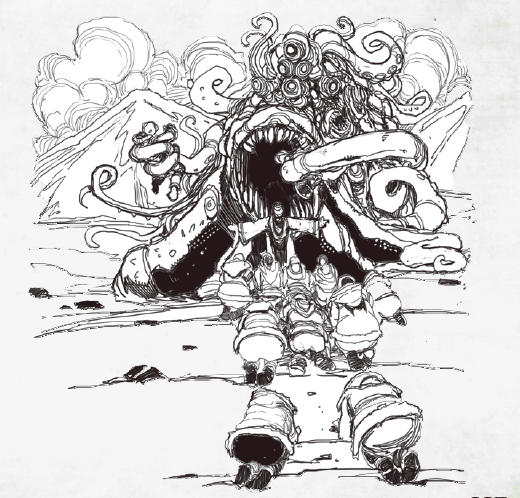
”All in all,” said Ralibar, “I wish I’d gone with the Roth IRA.”
Next time, on Carcosa : (rolls) Random (rolls) Monster (rolls) Tables. Damn! I wanted Logarithmic Equipment Pie-Charts.
Random Monster Tables!
Original SA post Supplement V: Carcosa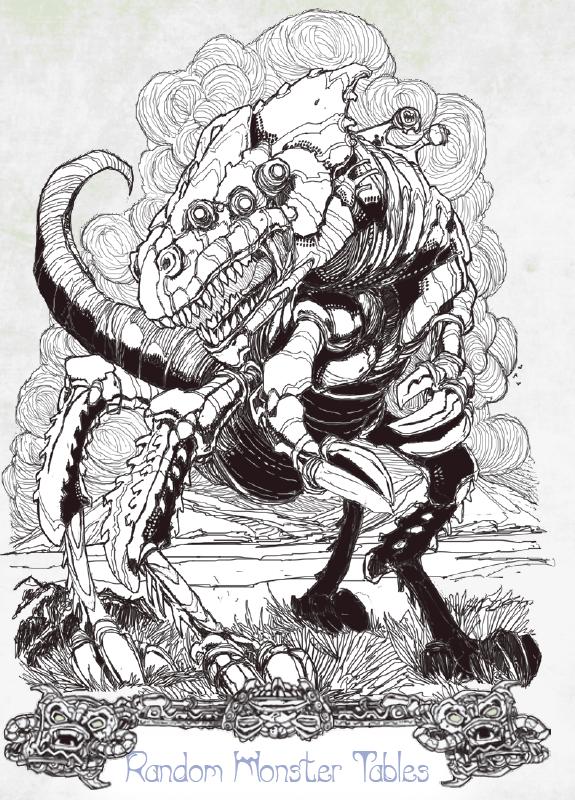
"I'm here for the gangbang."
Part X: Random Monster Tables!
Now we have come to the part of Carcosa which, it may be argued, comprises its truest essence, and what some would say is necessarily the heart and soul of any old school tabletop roleplaying experience: the tables! Travelers in Carcosa have a chance of encountering (possibly) (probably) (almost certainly) hostile forces once per day while traveling in the wilderness. Carcosa is divided into Arctic, Desert, Forest, Hills, Jungle, Mountains, Swamp, and Waste environments. Arctic and Water are safest (1/6 chance) while Jungle and Swamp are the most dangerous (3/6 chance).
If you have an encounter, you roll on another table to see what you encounter. The Water environment gets safer still, as you can only encounter Deep Ones, Dinosaurs, Lake Monsters, Men, Spawn of Shub-Niggurath, Space Aliens and Robots. (Yes, this is safer than the other environments, which contain nontrivial chances of encountering oozes and the other humanity-hating Spawn races.)
Encounters Underground
There's a subsection for underground (i.e. dungeon) encounters. There's a table showing you your encounter chance on a d6 based on what level you're on, which in turn leads to 6 subtables of creatures to encounter. Without explanation, encounters get more dangerous and difficult as you go deeper--men will be more numerous and better-armed, and Space Aliens and the like will have more and better technology for you to loot. Aside from the D&D convention that the dungeon must get dangerous as you go deeper, there's not rationale given at all for why you'll encounter a band of 10 well-armed veteran warriors deep underground and 4 peasants with knives near the surface. Nor is there any reason that the Space Aliens should post all their best-equipped explorers in a deep dark cave filled with oozebeasts. Moving on...
Spawn of Shub-Niggurath
The Spawn of Shub-Niggurath are the most numerous type of monster on Carcosa--they're on 5 out of 6 dungeon encounter tables, and in any wilderness environment you have at least a 12% chance of encountering them rather than another type of monster. I say "type" loosely because the whole point is that there are never more than a pack of any given Spawn.
Table 1: You roll to see if this is one Spawn, or a group of them. There's only a 5% chance of a Spawn not being unique, at least.
Table 2: If a group, roll to see how many. There can be as many as 2d6. (That's right, you roll three times to determine one number as simple as "how many are there?")
Table 3: Armor Class.
Table 4: Does it go on land, or fly, or swim, or two of these, or all three, or is it completely immobile? Find out on table 4!
Table 4a: How fast does it move?
Table 5: Hit Dice.
Table 6: Alignment. Chaotic, Neutral (intelligent) or Neutral (unintelligent).
Table 7: Body Type. This gives the author the chance to show off time-honoured Lovecraftian words like "batrachian" and "annelidoid."
Table 8: Colour.
Table 9: Hide. Is it furry, feathered, or (I hope I hope) squamous?
Table 10: How many eyes?
Table 11: What sort of mouth?
Table 12: Special Attacks! Spawn can induce madness, fear, poison, sickness, or kill you with aura and breath attacks.
Table 13: Special Defenses! Immunity to fire. Immunity to everything but fire. The list goes on.
Remember, these are the most numerous sort of random encounter on Carcosa, and it takes rolling on 14 tables to generate them. If McKinney didn't swipe the idea from the Forgotten Beasts in Dwarf Fortress, I'll eat my hat.
I don't have the MSPaint skills to actually draw any of these things, but of course I'm going to roll some up! Names provided courtesy of Seventh Sanctum's Lovecraftian names generator.
Thogot-ugtha is an orange amoeboid with 6 eyes, covered in suckered mouths. It is immobile, has no special attacks, and is immune to surprise. It is chaotic. HD 4, AC 13.
Yoacyst is a one-eyed, furred, red crustacean with a toothy maw. It is aquatic (90' speed) and can shoot spikes. It is chaotic. HD 7, AC 16.
Chanthu is a red amoeboid covered in many eyes and suckered mouths. It rolls across land (60' speed) and glides through water (120' speed). AC12, HD4.
Tha-tshugho is a dolm and yellow arachnoid, covered in feathers, with compound eyes and a toothy maw. It skitters across land (180' speed) flies through the air through unknown means (210' speed) and scuttles through the ocean easily enough (120' speed). The sight of it drives men insane, and it is harmed only by fire. It is chaotic. HD9, AC 14.
Magthuatt is a brown, smooth-surfaced plant. It has no eyes, and creeps across land (120') but propels itself more easily through water (180' speed). It is chaotic. HD 3, AC 16.
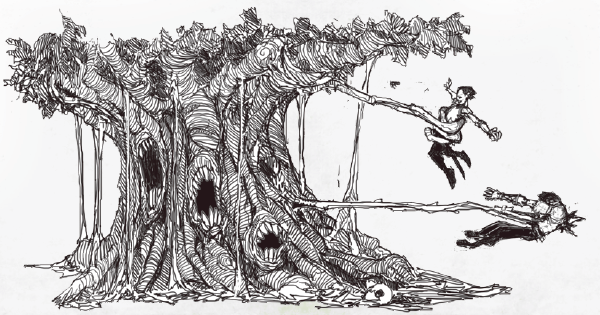
"Hey rape! merry rape! Rape a dape dillo!"
That's all I have in me to do this afternoon.
Next time, on Carcosa : Rayguns and Robots!
Space Alien Armament
Original SA post Supplement V: Carcosa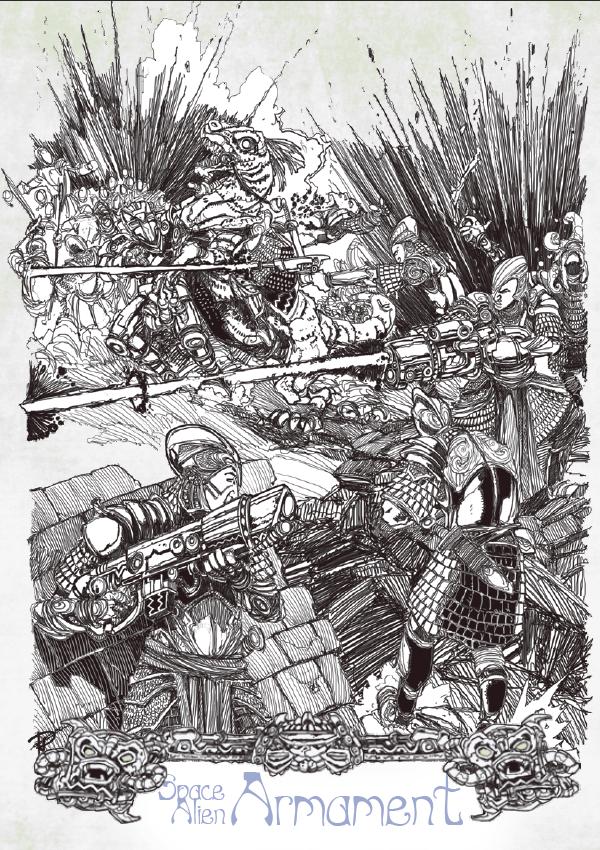
"Get some! Get some! Get some!"
Part XI: Space Alien Armament
Space Alien technology is, most likely, the PCs only chance of surviving on Carcosa for any significant amount of time. Considering that any random encounter might be a 9HD Spawn that induces madness and shits lasers at you, and Carcosa works off of OD&D rules by default, even a level 10 fighter (excuse me, "The Quintessence of Scintillating Pulchritude") in plate armor is not going to last too long in the wilderness. Humans can use Space Alien technology without too much trouble (relative to living in a world where a million things can randomly save-or-kill you) because the Space Aliens are humanoid Greys. I already detailed many specific pieces of Space Alien gear in an earlier update, but this section is concerned with the assortment that can be generated through a series of random tables...weapons.
Table 1: Type. Pistol, rifle, bazooka, cannon, or tank . The bigger ones deal higher base damage and have greater range, but have fewer charges.
Table 2: Projection Pattern. Pulse (single-shot), beam (line), ray (cone), or emitter (everything in a 180' or 360' arc).
Table 3: Projection Type. Electromagnetic, elemental, or special.
Table 4: Electromagnetic weapons, which can emit radio, microwave, laser, or even gamma or cosmic radiation (which do extra damage).
Table 4a: Laser colours, if you rolled Laser on table 4.
Table 5: Elemental weapon type! No, these aren't earth, air, and fire. They're all the elements on the periodic table. Seriously, there's one for every element. You can have a raygun that fires vanadium (double damage to Yellow Men) or Yttrium (half damage to Orange Men). This book devotes almost two full pages to the possibility that you will find a raygun, it will be an elemental raygun, and it will fire strontium at people.
Table 6: Special projectiles. Your raygun might shoot carnivorous slimes at people, or hardening foam, or a polymorph ray, or induce insanity. My favourite is the Logic Beam, which can disrupt a sorcerer's spell. I wish this really existed, so that someone could use it on the author and on Rick Santorum.
Of course I'm going to roll up some of these suckers.
This rifle fires a beam of microwave radiation. (range: 1,000′, base damage: 2 dice, charges: 50)
This pistol is a handheld emitter which strikes everything in a 180' or 360' arc with a flash of dolm laser energy. (range: 300′, base damage: 1 die, charges: 100)
This bazooka fires a beam of charged selenium (double damage to Brown Men). (range: 3,000′, base damage: 3 dice, charges: 25)
This cannon fires a cone-shaped ray of hardening foam. Anything struck must save vs. paralyze or be trapped in foam. (damage: none, range: 4 miles, charges: 15.)
(Yes, that's right. I'm not sure how wide the cone will be at the end of its 4 mile blast zone. And it's covering all of that in hardening foam.)
This cannon fires a lanthanum beam (half damage to Red Men). (range: 20 miles, base damage: 5 dice, charges: 15)
This rifle fires pulses of protactinium (half damage to Ulfire Men). (range: 1,000′, base damage: 2 dice, charges: 50)
This tank fires pulses of cosmic radiation. (range: 10 miles, base damage: 6 dice, charges: 15)
This bazooka fires a cone-shaped ray of europium (half damage to Purple Men). (range: 3,000′, base damage: 3 dice, charges: 25)
This bazooka is an emitter which strikes everything in a 180' or 360' arc with a flash of uranium (double damage to Black Men). (range: 3,000′, base damage: 3 dice, charges: 25)
Yes, these rules do mean that your PCs might find a tank which will blast every living thing in a 10 mile radius--with gamma radiation, or lasers, or insanity-inducing rays, or by coating them with ooze monsters or teleporting them in a random direction. The book offers no guidance on whether or not you can fire a 360' pistol-sized emitter without being struck yourself, or what such weapons do to trees and rocks and buildings and the like.
Random Robots
Robots are by their nature randomized--"the Space Alien roboticists seem to disapprove of mass production." Here's a rundown of the tables one uses to create Carcosan robots. I suppose the Yithians and Elder Things don't like building robots.
Table 1: Morphology. Humanoid, Spherical, slinky-shaped (seriously), serpentine, and so on.
Table 2: Armor Class.
Table 3: Hit Points. Finally, something in this book just has a flat sum of HP.
Table 4: Movement types--one to three.
Table 4a: Movement types. In addition to land, sea, and air, robots may be burrowers or be able to fly through outer space!
Table 4b: Land-moving robots might move with legs, wheels, treads, tentacles, etc.
Table 5: Speed.
Table 6: "Number of offensive systems." Up to 5. This is really annoying because you roll 1d10, which will then direct you to roll 1-3 or 2-4 or 5+.
table 6a: Types of roboweapons. In addition to Space Alien projectile weapons, they might have tractor beams, missiles, nets, or gas weapons.
Table 7: Defensive systems. Up to 3.
Table 7a: Types of defensive systems. Force fields, absorption fields, regeneration, armor, illusion, invisibility, repulsors, and smoke screens.
Table 8: Special detection systems. Roll 1d4 to determine how many times you roll on this one. They include things like motion sensors, geiger counters, infrared, and sonar.
Following is a helpful note regarding other neat things robots can have, like a self-destruct system, or limbs designed for vivisecting living things. Joy. Okay, let's randomly roll some rock'em sock'em robots. Names provided courtesy of another random generator.
The Perfectroid is a humanoid robot. It can fly through deep space, hover above the ground (210' speed) or travel on wheels (180' speed). I suppose it has internal rollerskates. Its design incorporates a hallucinogenic gas emitter (effects unspecified) and a jale laser beam rifle. When threatened, it emits a smokescreen. (AC 17, HP 60.)
The Robo Steel Machine Colossus is a serpentine robot. It hovers above the ground (240' speed) or crawls on treads (150' speed). Its design incorporates an iron ray pistol. (AC 19, HP 50.)
The Sea Beamer is a humanoid robot; however, it can only swim or glide on the surface of the water (180' speed). Its design incorporates grappling lines and a poison gas emitter. When threatened, it emits a force field. (AC 18, HP 40.)
The Panzer Behemoth Machine is a coil-shaped robot. It winds over the land's surface on a series of tentacles. Its design incorporates a microwave pulse rifle, a grenade launcher, and an emitter which blasts everything within a 20-mile radius with a flash of actinium laser energy (double damage to Blue Men). When threatened, it emits an absorption field. (AC 19, HP 100).
The Refittable Infiltrator is a spherical robot. It runs across the land on retractable legs (120' speed) or by leaping (90' speed). Its design incorporates a grenade launcher, minimissile bays, an argon beam pistol (double damage to Blue Men), and a shrinking beam rifle (save vs. device or shrink to 10% size for 24 hours). It is coated in refractive armor (-2 to hit)*. (AC 19, 90 HP.)
*I want to give the author hell for this, since AC already reflects armor, but that's how magic armor worked in OD&D: A penalty to the attacker's to-hit roll rather than extra AC. Flash fact!
Mutations
Hold your horses, pal, this ain't Gamma World. Mutations almost always suck. They include things like your eyes melting, your skin becoming transparent (permanent Charisma 3), legs fusing into a tail, obligate cannibalism, and very rarely something slightly useful like sharp teeth or venomous claws.
All that follows, before the index and hexmap, is a compiled table of sorcerous rituals, with a reminder that after all the hard work and mass murder you put into casting them, the entity still gets a saving throw to resist it, and whether you succeed or fail, you have to save against unnatural aging.
Next time, on Carcosa : They all died. The end!